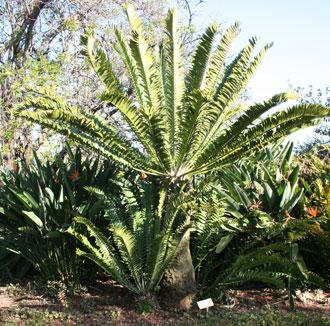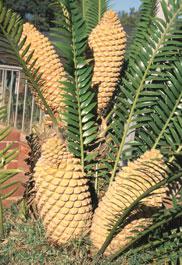Encephalartos natalensis
Encephalartos natalensis R.A.Dyer & I.Verd.
Family: Zamiaceae
Common names: Natal cycad (Eng.); natalbroodboom (Afr.); isigqikisomkhovu, umhlungulo (Zulu); umguza, umphanga (Xhosa)
SA Tree No: 10
Introduction
Encephalartos natalensis, a "living fossil", is a quick-growing handsome giant tree cycad for your garden. This frost-hardy cycad prefers subtropical to warm or hot temperate climates.

Description
Description
Encephalartos natalensis is an evergreen quick-growing cycad, up to 6.5 m high and with a stem or trunk of about 0.4 m in diameter. The stem sometimes branches, but reclines only when other stems emerge from the base. It has a golden, woolly crown, which increases on production of cones or new whorls of leaves. The leaves are of medium size, about 1.5-3 m long and slightly curved or straight. The leaflets are about 160-230 x 25-45 mm, dark green and entire or with 1-5 teeth on one or both margins. The lower leaflets are reduced to spines. New leaves and cones are covered with yellowish brown wool. There are separate male and female plants; both genders produce 2 or 3 orangy-yellow to orangy-red cones.
The male cones are cylindrical, yellowish-green, velvety, about 450-500 mm long, and 90-120 mm across, and shed their pollen in April to June. The female cones are oblong to oblong-ovate, about 500-600 mm long and 250-300 mm in diameter. The faces of the cone scales are wrinkled. The cones disintegrate spontaneously from November to January, each yielding 415-510 bright red seeds which are about 25-35 mm long and 12-18 mm in diameter.


Conservation Status
Status
Through the years, vast numbers of Encephalartos natalensis have been removed from their natural habitat, primarily for landscaping purposes. According to Raimondo et al. (2009), Encephalartos natalensis is regarded as Vulnerable (VU). This is the category used when the best available evidence indicates that the plant meets any of the five IUCN criteria for Vulnerable. Therefore it is probably facing a high risk of extinction in the wild.
Distribution and habitat
Distribution description
Encephalartos natalensis is endemic to South Africa, occurring from Tabankulu in the northern part of the Eastern Cape, through most of KwaZulu-Natal, up to the upper catchment area of the Umfolozi River, near Vryheid in the north. It grows on cliffs, in forests, and on rocky outcrops, where the climate is hot in summer and cold in winter, with frost occurring regularly. The altitude is about 1200 m above sea level.
Derivation of name and historical aspects
History
The name Encephalartos was derived from a Greek word for bread in head and refers to the floury, starchy material in the trunk of some species used traditionally as food. The specific name natalensis means from Natal, which is now KwaZulu-Natal. This cycad is the most variable of all Encephalartos species. It is closely related to E. altensteinii, a species that occurs in the Eastern Cape. It was considered to be part of the E. altensteinii complex until Dyer & Verdoorn separated the two species in 1951.
E. natalensis can be differentiated from E. altensteinii, because the former's lower leaflets are reduced to spines. It can also be confused with E. msinganus, which was considered to belong to E. natalensis until it was described as a new species by P.J. Vorster in 1996. E. msinganus has narrow leaflets, about 16-20 mm wide, and its female cone is warty. E. natalensis is also closely related to E. lebomboensis, E. senticosus and E.woodii. Cycads are regarded as "living fossils", as their relatives have been found as fossils in rocks dated back to the Triassic Era. This means that during that era these plants could have been dinosaur food!
Ecology
Ecology
Encephalartos natalensis is not threatened by fire in its natural habitats. This is because the rocky environment and the evergreen vegetation associated with it provide good protection. However, the larvae of the leopard magpie moth, Zerenopsis leopardina, do cause considerable damage to its foliage in some areas. The seeds of cycads may be poisonous to humans, but fruit-eating animals such as trumpeter horn-bills, monkeys, rodents, bats and baboons eat the outer part of the fruit. The poisonous hard-coated kernel is discarded or regurgitated.
Uses
Use
The bark of Encephalartos natalensis is harvested for the muthi trade in most parts of K waZulu-Natal. It is also grown as an ornamental plant in gardens. In times of famine the pith of the stem was used as a substitute for bread flour, hence the common names.
Growing Encephalartos natalensis
Grow
Propagate from seed. Encephalartos natalensis grows relatively quickly and thrives in light shade or sun. Plant it in a well-drained rich soil mixture and give it moderate moisture. Some forms of E. natalensis are much more frost resistant than others, but give all of them some protection from cold when young. Plant seedlings into the garden when about 3 years old, and with leaves about 1 m long. Remove any old and dead leaves.

References
- Anderson, J.M. & Anderson, H.M. 1985. Palaeoflora of southern Africa. Balkema, Rotterdam.
- Barkhuizen, B.P. 1975. The cycad garden of UNISA. UNISA Press, Pretoria.
- Boon, R. 2010. Pooley's trees of eastern South Africa: A complete guide, edn 2. Flora & Fauna Publication Trust, Durban.
- Giddy, C. 1974. Cycads of South Africa. Struik, Cape Town.
- Goode, D. 1989. Cycads of Africa. Struik, Cape Town.
- Grobbelaar, N. 2002. Cycads with special reference to the southern African species. Author, Pretoria.
- Joffe, P. 2001. Creative gardening with indigenous plants. A South African guide. Briza Publications, Pretoria.
- Raimondo, D., Von Staden, L., Foden, W., Victor, J.E., Helme, N.A., Turner, R.C., Kamundi, D.A. & Manyama, P.A. (eds). 2009. Red List of South African plants 2009. Strelitzia 25. South African National Biodiversity Institute, Pretoria.
Credits
M. S. Mothogoane
National Herbarium, Pretoria
October 2011
Plant Attributes:
Plant Type: Tree
SA Distribution: Eastern Cape, KwaZulu-Natal, Mpumalanga
Soil type: Sandy, Clay, Loam
Flowering season: Early Summer
PH: Neutral
Flower colour:
Aspect: Full Sun, Shade
Gardening skill: Average
Special Features:
Horticultural zones











Rate this article
Article well written and informative
Rate this plant
Is this an interesting plant?
Login to add your Comment
Back to topNot registered yet? Click here to register.